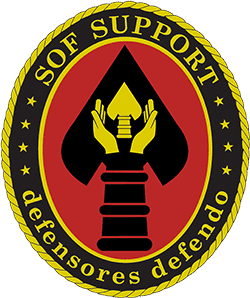The NICoE: Ten years of Healing ‘The Invisible Wounds of War’
The National Intrepid Center of Excellence at Walter Reed National Military Medical Center houses the Computer Assisted Rehabilitation Environment (CAREN), a magnetoencephalography (MEG) machine used to analyze and train patient movement for peak efficiency and optimal execution. (WRNMMC photo).
The National Intrepid Center of Excellence first opened its doors to patients in June 2010, and Military Health System officials celebrated the 10th anniversary of the center, dedicated to advancing the nation’s understanding of and healing the invisible wounds of war, during a ceremony June 25 at the facility.
The interdisciplinary model of care developed at the NICoE, a part of Walter Reed National Military Medical Center, brings together neurologists, psychologists, family care doctors, psychiatrists, nutritionists, neuropsychologists, therapists, specialists and other professionals under one roof. This team collaborates in the diagnosis, treatment and care of MHS beneficiaries affected by traumatic brain injury (TBI) or those who may exhibit symptoms of post-traumatic stress (PTS). Their efforts have proven effective and allowed more than 90 percent of patients treated at the NICoE to continue on active duty in the armed forces, according to NICoE officials.
Research, treatment modalities and services at the NICoE include neuroimaging, art therapy, music therapy, animal-assisted therapy, audiology and vestibular care, a brain fitness center, driving assessment and rehabilitation, family education, and other complementary and integrative medicine techniques such as biofeedback, acupuncture and yoga. This Center of Excellence also houses the Computer Assisted Rehabilitation Environment, a magnetoencephalography machine used to analyze and train patient movement for peak efficiency and optimal execution, and a 3T Magnetic Resonance Imaging scanner, which provides researchers access to cutting-edge image acquisition methods, such as multiband diffusion tensor imaging and echo planar imaging sequences.
Last year, more than 2,000 patients received care from NICoE providers in more than 34,000 clinical encounters in the four-week Intensive Outpatient Program, in TBI outpatient services, and in collaboration with inpatient teams from other WRNMMC directorates, figures from NICoE indicate.
Navy Capt. (Dr.) Walter Greenhalgh, NICoE director, credited “the persistent, strong advocacy of leadership from WRNMMC, the National Capital Region Market, the Defense Health Agency and the Department of Defense” for NICoE’s ability to provide “safe, reliable and innovative” health care to the nation’s heroes and their families. He added that, WRNMMC’s leadership has “held a spotlight on NICoE while continuously pushing the NICoE team to strive to be the best that it can be, guiding NICoE to make the most of the amazing resources it’s been granted by the American people, while integrating TBI into the MHS’s Pathway of Care.”
“The WRNMMC leadership has held NICoE to the same high standards of safe, quality health care as they have with the rest of the hospital because the most deserving of patients and their families deserve nothing less,” Greenhalgh said. He added, how the standard of care has extended nationwide through the NICoE network of facilities and providers in the Intrepid Spirit Centers.
Dr. Thomas DeGraba, chief innovation officer and deputy director of NICoE, said what has remained unwavering since the center first opened its doors, is “the outstanding dedication and expertise of the NICoE staff to do what’s necessary at any cost to be able to help service members recover from the injuries they sustained in the protection of this country.”
The National Intrepid Center of Excellence at Walter Reed National Military Medical Center, which is celebrating its 10th anniversary this year, offers patients affected by traumatic brain injury and post-traumatic stress, driving assessment and rehabilitation, in addition to a number of other treatment modalities. (WRNMMC photo)
DeGraba added that, NICoE helped break down the stigma of those treated for TBI and PTS. He explained how TBI and PTS were once thought to be untreatable, and troops were medically dischargedout of the service without a good strategy for recovery.
“This center, along with a number of colleagues through the MHS, have proven [TBI and PTS are treatable],” DeGraba said. “The brain does heal, and service members can come up with strategies to be able to deal with those stressors that have caused them challenges so they can get back to productive lives, as well as get back to the interpersonal relationships with their families and friends that many times are disrupted by TBI and psychological health issues,” he furthered.
Army Col. (Dr.) Andrew Barr, WRNMMC director, also saluted NICoE and its staff for its 10 years of serving the nation, its heroes and their families.
“These past few months and this global pandemic have shown us just how adaptable and resilient we can be in times of great uncertainty and change. NICoE has led the way at this time with innovative approaches to maintain our missions,” Barr said. He added that this is indicative of NICoE achieving countless examples of excellence during his decade-long history.
“The words ‘Center of Excellence’ are more than just buzz words,” Barr continued. “You are a center of excellence in the truest definition of the term. This is reflected in the patient care, research and education that happens here every day, and the tangible, positive improvements made in the lives of our patients and their families.”
“NICoE’s guiding principles of excellence, innovation, compassion, collaboration and honor are evident in all that you do, and your patient- and family-centered holistic approach to TBI research and care, serve as a model throughout the MHS and for many other health organizations across the globe,” Barr concluded.
In an interview published in the February 2015 National Geographic focused on “Healing Our Soldiers, Unlocking the Secrets of Traumatic Brain Injury,” Army Staff Sgt. Perry Hopman discussed how NICoE’s arty therapy program helped him.
Hopman, who served as a flight medic in Iraq, said about the art therapy, “I think this is what started me kind of opening up and talking about stuff and actually trying to get better.”
